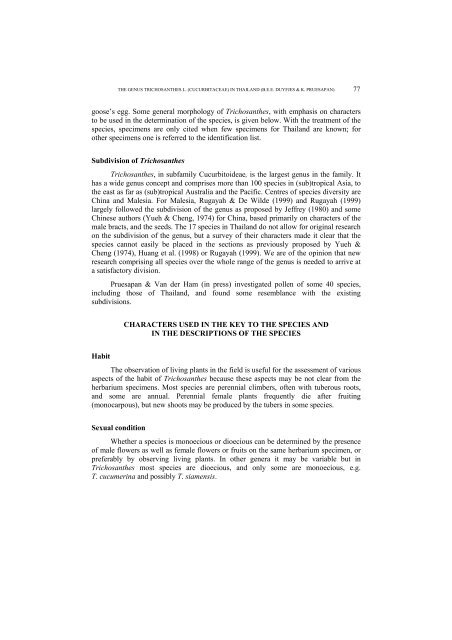The genus Trichosanthes L. (Cucurbitaceae) in Thailand ...
The genus Trichosanthes L. (Cucurbitaceae) in Thailand ...
The genus Trichosanthes L. (Cucurbitaceae) in Thailand ...
You also want an ePaper? Increase the reach of your titles
YUMPU automatically turns print PDFs into web optimized ePapers that Google loves.
THE GENUS TRICHOSANTHES L. (CUCURBITACEAE) IN THAILAND (B.E.E. DUYFJES & K. PRUESAPAN) 77<br />
goose’s egg. Some general morphology of <strong>Trichosanthes</strong>, with emphasis on characters<br />
to be used <strong>in</strong> the determ<strong>in</strong>ation of the species, is given below. With the treatment of the<br />
species, specimens are only cited when few specimens for <strong>Thailand</strong> are known; for<br />
other specimens one is referred to the identification list.<br />
Subdivision of <strong>Trichosanthes</strong><br />
<strong>Trichosanthes</strong>, <strong>in</strong> subfamily Cucurbitoideae, is the largest <strong>genus</strong> <strong>in</strong> the family. It<br />
has a wide <strong>genus</strong> concept and comprises more than 100 species <strong>in</strong> (sub)tropical Asia, to<br />
the east as far as (sub)tropical Australia and the Pacific. Centres of species diversity are<br />
Ch<strong>in</strong>a and Malesia. For Malesia, Rugayah & De Wilde (1999) and Rugayah (1999)<br />
largely followed the subdivision of the <strong>genus</strong> as proposed by Jeffrey (1980) and some<br />
Ch<strong>in</strong>ese authors (Yueh & Cheng, 1974) for Ch<strong>in</strong>a, based primarily on characters of the<br />
male bracts, and the seeds. <strong>The</strong> 17 species <strong>in</strong> <strong>Thailand</strong> do not allow for orig<strong>in</strong>al research<br />
on the subdivision of the <strong>genus</strong>, but a survey of their characters made it clear that the<br />
species cannot easily be placed <strong>in</strong> the sections as previously proposed by Yueh &<br />
Cheng (1974), Huang et al. (1998) or Rugayah (1999). We are of the op<strong>in</strong>ion that new<br />
research compris<strong>in</strong>g all species over the whole range of the <strong>genus</strong> is needed to arrive at<br />
a satisfactory division.<br />
Pruesapan & Van der Ham (<strong>in</strong> press) <strong>in</strong>vestigated pollen of some 40 species,<br />
<strong>in</strong>clud<strong>in</strong>g those of <strong>Thailand</strong>, and found some resemblance with the exist<strong>in</strong>g<br />
subdivisions.<br />
CHARACTERS USED IN THE KEY TO THE SPECIES AND<br />
IN THE DESCRIPTIONS OF THE SPECIES<br />
Habit<br />
<strong>The</strong> observation of liv<strong>in</strong>g plants <strong>in</strong> the field is useful for the assessment of various<br />
aspects of the habit of <strong>Trichosanthes</strong> because these aspects may be not clear from the<br />
herbarium specimens. Most species are perennial climbers, often with tuberous roots,<br />
and some are annual. Perennial female plants frequently die after fruit<strong>in</strong>g<br />
(monocarpous), but new shoots may be produced by the tubers <strong>in</strong> some species.<br />
Sexual condition<br />
Whether a species is monoecious or dioecious can be determ<strong>in</strong>ed by the presence<br />
of male flowers as well as female flowers or fruits on the same herbarium specimen, or<br />
preferably by observ<strong>in</strong>g liv<strong>in</strong>g plants. In other genera it may be variable but <strong>in</strong><br />
<strong>Trichosanthes</strong> most species are dioecious, and only some are monoecious, e.g.<br />
T. cucumer<strong>in</strong>a and possibly T. siamensis.
















